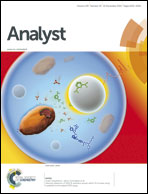Development of molecularly imprinted electrochemical sensors based on Fe3O4@MWNT-COOH/CS nanocomposite layers for detecting traces of acephate and trichlorfon†
Abstract
In this study, we developed a novel biomimetic electrochemical sensor sensitized with a Fe3O4@carboxyl-functionalized multiwalled carbon nanotube/chitosan nanocomposite layer using a molecularly imprinted film as a recognition element for the rapid detection of acephate and trichlorfon. The performance of the imprinted sensor was investigated using cyclic voltammetry and differential pulse voltammetry, and the results indicated that the sensor exhibited fast responses to both acephate and trichlorfon. The imprinted sensor had good linear current responses to acephate and trichlorfon concentrations in the ranges from 1.0 × 10−4 to 1.0 × 10−10 M and 1.0 × 10−5 to 1.0 × 10−11 M, respectively. Under optimal conditions, the imprinted sensor had low limits of detection (signal to noise ratio, S/N = 3) of 6.81 × 10−11 M for acephate and 8.94 × 10−12 M for trichlorfon. The developed method was successfully applied to detect acephate and trichlorfon spiked in fortified kidney bean and cucumber samples with good recoveries ranging from 85.7% to 94.9% and relative standard deviations of 3.46–5.18%.


 Please wait while we load your content...
Please wait while we load your content...